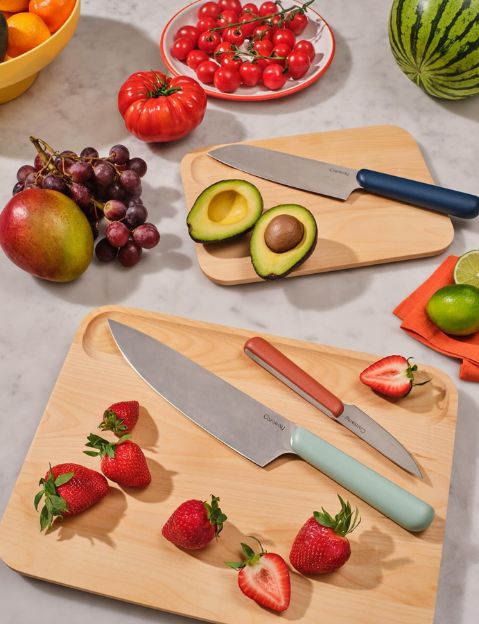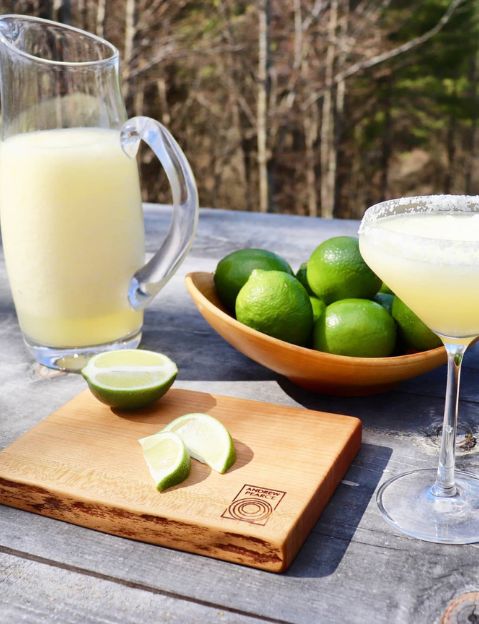Last updated: September 12, 2024
I spend a lot of time in the kitchen experimenting with scraptastic recipes and photographing my favorites. In fact, my new cookbook, 101 Tips for a Zero Waste Kitchen, is available for purchase now.
I can’t tell you how much time I spent cutting food on a cutting board. The average American spends about 400 hours a year in the kitchen, but I may be beating that statistic.

Some of the links in this post are affiliate links. Please see my disclosure policy for more information.
But I say based on experience that not all cutting boards are created equal. Having made over 90 crude recipes for my cookbook, I needed something that would not only be durable, but wouldn’t release microplastics every time I chopped it.
If you have a plastic cutting board or a wooden cutting board with a plastic coating, you may be ingesting a significant amount of microplastics from just the cutting board (more on that later).
That’s why we recommend switching to wooden cutting boards without plastic coatings or adhesives.
Obtaining durable solid wood boards is an investment that will pay off for your health and the planet. You just need to make sure that the brand sources their wood sustainably and that no potentially questionable coatings, adhesives, or finishes are used.
Here are some of the best wooden cutting board brands on the market.
Should I stop using plastic cutting boards?
If you use a plastic cutting board, consider switching to a wooden cutting board. Plastic cutting boards shed microplastics that are released when you cut on the board.
A recent study investigated how two types of plastic cutting boards (polyethylene and polypropylene) release microplastics into human food.
The study found that the annual per-person exposure was between 7.4 and 50.7 g of microplastics from polyethylene cutting boards and 49.5 g from polypropylene cutting boards. In other words, both released microplastics, but polypropylene was proven to release more.
These microplastics end up in our food and ultimately affect us. Microplastics have recently been discovered in human blood, feces, placenta, and even the brain. The health effects of ingesting microplastics are still being studied, but it cannot be said that they are positive.
While it’s impossible to avoid microplastics completely, reducing the amount we’re exposed to each day is a good place to start.
This can be achieved by switching to a wooden cutting board without plastic resins or coatings.
Other ways to avoid microplastics include:
Choose natural materials (cotton, linen, linen, etc.) for clothing and bed sheets whenever possible. Dust and vacuum frequently (microplastics linger in dust and can be accidentally inhaled). Switch to plastic-free tea bags that are labeled compostable on the packaging (Yogi and Pukka are good examples). You can also support Arbor Teas, which offers an assortment of loose-leaf teas in compostable packaging. Or, get loose-leaf tea without packaging at your local mass retailer.
What can I use instead of a plastic cutting board?
Instead of plastic cutting boards, you can use wooden, glass, or stone cutting boards. Wooden is my personal preferred method.
However, keep in mind that not all wood cutting boards are created equal. Many wooden cutting boards come with adhesive or resin.
Some wooden cutting boards are made from a single block of wood, but many contain pieces of wood that are glued together.
Because any part of the cutting board can come into contact with food, the cutting board material falls under FDA’s “food contact substance” and “indirect food additive” regulations.
The FDA considers food contact materials, such as adhesive resins/polymers, to be food safe when fully cured (completely dry).
However, some approved materials, such as melamine formaldehyde resin, can emit harmful gases and cause similar problems for human and environmental health.
For this reason, it’s best to avoid wooden cutting boards that have been formulated with adhesive resins or polymers. This can be achieved by looking for solid wood planks. Many traditional wooden cutting boards are simply made of different woods glued together.
However, finding a non-adhesive wood cutting board can be difficult. If you are unsure, always contact the brand and ask.
If you really can’t avoid wood cutting board glue, FYI: Titebond III and Gorilla Wood Glue are both considered safer for food contact.
Also, be aware that petroleum-based wood preservatives such as paraffin wax and petroleum hydrocarbon resins are sometimes used as finishes. It is advisable to look for boards that have a beeswax coating or no coating at all.
What is the best wood for cutting boards?
The best woods for cutting boards are hardwoods such as maple, walnut, and birch. This is because it is highly durable and does not absorb moisture easily.
Ideally, you should look for a wood cutting board that is Forest Stewardship Council (FSC) certified. This ensures that the wood comes from sustainably managed forests.
However, bamboo is another option that is similar to wood. Strictly speaking, it is classified as a grass rather than a “wood,” but it has characteristics similar to hardwoods.
Additionally, bamboo grows faster than hardwoods and is therefore renewable. That’s why we decided to include some bamboo cutting board options alongside traditional wooden cutting boards in this roundup.
How to care for a wooden cutting board
One of the disadvantages of wooden cutting boards is that they tend to warp and dry out easily. But all this is preventable. Handle with care and always wash by hand (definitely avoid the dishwasher!).
It is also recommended to oil the board regularly. This will ensure that your wooden cutting board lasts for years to come.
To clean a wooden cutting board:
Hand wash using a wooden dish brush and mild detergent (bar or liquid soap will suffice). Let it dry completely naturally before storing. For stubborn stains, sprinkle with baking soda and scrub. If your board is smelly, use salt and lemon to deodorize your board.
To oil a wooden cutting board:
If you notice your board becoming brittle and dry, apply some oil and wax. This plant-based cutting board oil from Real Milk Paint is mineral oil-free and non-toxic. Add a small amount to the board and let the oil sit on the surface for at least 10 to 15 minutes and up to 24 hours. Buff the surface with a clean, lint-free cloth to remove excess and create a shine. If desired, you can also finish with Real Milk Paint wood wax. Use a clean cloth to apply the wood wax, let it sit on the surface for 10 to 15 minutes, then wipe off any excess wax with another clean cloth. Be sure to wait 5-7 days before using your cutting board lightly. Real Milk Paint Co. wood wax takes 15-30 days to fully cure, so plan your project accordingly.
Whether you oil or wax your board depends on when the board looks dry (or starts to dry).
Ideally, you should lubricate your car every month, but there is one surefire way to tell if it needs lubrication. The board is well lubricated if you sprinkle a few drops of water on it with your fingertips and it beads up. However, as water disperses or penetrates the wood, the board will require more oil.
gzw approved wooden cutting board
Here are some brands that sell wood cutting boards and have the Going Zero Waste seal of approval. Many of these brands use FSC-certified wood, and many are handcrafted from a single plank of wood (rather than gluing different pieces together).
We’ve highlighted some of the main characteristics of each brand, but this is not a complete list. Be sure to check out their website for more information.
1. Caraway
Set of 4 FSC-certified birch boards (small, medium, large) with storage organizer, mineral oil + wax finish
I haven’t tried the Caraway cutting board, but I have tried the cookware and bakeware. I can attest that their products are of high quality, so I have no doubt that their cutting boards are sound as well.
2.Bamboo
Made from FSC certified bamboo Medium + large size options Manufactured using formaldehyde-free water-based food grade adhesive imported from Europe Hand-finished with food-safe wood oil USDA certified bio-based No lacquer coating B Corporation
I tried their cutting boards before and loved them! I have a small one. I’ve been using it for about a year now, and it’s held up really well. It’s incredibly durable and looks really great! I also have wood oil and bamboo oil which are great for board maintenance.
3. Made a transaction
Made from sustainably harvested teakwood Small and large size options Handcrafted in Panama by Trasto’s skilled artisans
4. Wooden board
Sustainably sourced maple and oak wood cutting boards Made without glue or petroleum products Carved from blocks of wood in our Maryland workshop Handcrafted with organic raw linseed oil and our proprietary board balm Finished with work. Each board comes with a free can of our own plant-based board balm.
5. Andrew Pearce
Made from responsibly sourced cherry or walnut wood Small, medium and large size options Live edge cutting board made without adhesives Made with food-safe and allergen-free walnut wood oil Finished Handcrafted in Vermont
What do you think about these wood cutting board options? Let us know in the comments!











